Quick update on the war in Ukraine--Kursk
The plan was to hold off on a war update until late this week. Yet, to paraphrase Mike Tyson, everybody has a plan until they get punched in the face.
Which is exactly what Russia learned over the past week southwest of Kursk.
That said, a bit of sobriety is in also in order—and news reports have been frankly all over the place. So here are a few points to consider.
- Ukraine has remained mum for a reason—and the fallback confirmation option, DeepState UA, has not updated gains, and it won’t update gains during a Ukrainian offensive as critical as this.
- More than one story here can be true. Tales that Ukraine has penetrated 30-40 kilometres can be true. Tales that it has only managed 10 can be true. Tales that only hundreds of Ukrainians are fighting are very unlikely, but to a point could be true, as could tales of 1,000 to 3,000. Or more. We’ll get to that in a moment.
- The Kursk strike could be brilliant or it could be insane. Or it could be brilliantly insane.
- Pokrovsk still matters.
- Ukraine's stance that the war must be brought to Russia is neither unreasonable and nor should this be underestimated. Strikes on civilian targets in Ukraine are still ongoing (as indicated by the photo from an Aug. 6 strike in Kharkhiv)--and a Russian strike on a supermarket in Konstiantynivka that killed 14 and injured 43 Aug. 9 are only the latest of such that by definition should be considered yet more war crimes/efforts to commit genocide.
- Finally, Pokrovsk still matters. But possibly the Kursk strike is the one effective move that Ukraine could play at this time.
Now a quick take (and we are going to keep this update rather in general/simplified form): There have been reports that Ukraine has thrown two brigades into the Kursk strike. That could mean anywhere from 3,000 to 6,000 personnel or more. This upper figure is highly unlikely. Then again, Russia has claimed 1) that Ukraine sent in 1,000 personnel--and as this is Russia, it's claims with regard to destroyed armour and personnel would seem to indicate that the figure must be higher.
That said, attempting to pin figures down at this point is practically impossible. Likewise, there is, as already mentioned, a tendency to forget Pokrovsk in the bigger picture. That said, this is what Yours Truly currently believes to be (more or less) the case.
- Head of Ukrainian military intelligence Lt. Gen. Kyrylo Budanov is once again likely the chief architect of an incredibly effective (and for the Russians, damaging) series of moves designed to take pressure off of the Ukrainian defenders attempting to slow down the drive toward Donetsk (and not only) while also dealing Putin a slap in the face that may be highly rewarding come November.
- Likely Budanov quietly put together elite forces over the past months—and reports in the West putting Ukrainian personnel in the Kursk region at “several hundred” are likely to simply be seriously wrong. This could be a figure attributed to highly trained special forces, but likely even that is a low figure, and based on The Corners’ sources, a number closer to 1,000 elite personnel backed by highly seasoned elements of various regiments hand-picked for the operation is more likely, and 3,000 personnel remains our rough guestimate.
- This hand-picking may well have weakened positions on some fronts, but (again, despite reports in the West) this is unlikely to have had a true detrimental effect, for example, beyond Ocheteryne or at Chasiv Yar (or on the Kupiansk or Svatove) fronts. True, Ukraine is extremely personnel strapped. That said, there are rumours that hard-to-come-by replacement troops are getting more training and gradually being filtered to front line areas—which is a much more positive development than what was openly said months ago when the tide at various fronts began to turn sharply against Ukraine (beginning in Avdiivka). Yet, more importantly, the use of elite forces at such defensive points was likely seen as no less than a waste of Ukraine’s best personnel. Why? Glide bombs. Russia’s strategy of using massive glide bombs to hit dug in positions and even to completely obliterate built up or industrial areas means that defenders must pull out simply because there is nothing left to defend (and typically the thermobarics are also coming). This has meant, for example, that Russian forces have continued to creep toward Pokrovsk at approximately 1-1.5 kilometres every day (or now every two days). And if elite forces remain at said positions, they will simply be hit by glide bombs as well.
- Which brings us to the Kursk strikes. Notably, since these operation have begun, the use of glide bombs (and even thermobarics) have decreased notably on other fronts. Likewise, Russian President Vladimir Putin, clearly embarrassed by Ukrainian activity near Kursk and Belgorod—and clearly plagued by calls from Russian citizenry (and mass evacuations or spontaneous evacuations) has called his own military on the carpet. This is not small factor, as Budanov not only picked a region that was sparsely and chaotically defended, but also this is a region with limited road access when it comes to attempting to bring in Russian reserves—especially as the number of displaced persons at this time likely has already meant more than 70,000 on the roads out. Morever, reportedly (but believably) the Russian military has pulled some of the most effective and battle-hardened elements of its brigades in Zaporizhzhia, Donetsk and even Svatove and Kupiansk.
- This latter point is more important than might at first be understood. Only a year ago a massive build up in Svatove and Kupiansk was all but thwarted by the ill-fated Ukrainian counter-offensive. As reported there then, battled-hardened troops at Kupiansk were transferred by Russia to the Robotyne and Staromayorske fronts, and little progress has been made at Kupiansk since. This is primarily because while Russia has no end to “meat waves,” the Ukrainian war has taken a tremendous toll on elite units and armour.
True, the above conclusions are off-the-cuff and based on very partial information, but there are reasons to believe that we are on track. Uncharacteristically, Russian state media is warning that the Kursk strike will not simply be nipped in the bud, and that citizens should expect a protracted fight. Second, the Ukrainian mini-counter offensive (as these are more than simple guerrilla operations) is… complex. A bit of rough mapping makes this clear. First, below is a general map which indicates in blue (very roughly) current Ukrainian activity. Red arrows are theoretical to simply indicate from where Russia must pull battle-hardened troops to stop the Ukrainians.
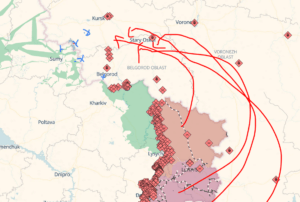
At present, geo-located firefights are hard to read, with battles even to the west of and just south of Kursk and still further west near Korenevo. Most importantly, it appears that Ukrainian forces have dug in hard at Sudzha, which would represent only a 10 kilometre advance (which is also often reported in the media), but this is an undersell. Ukrainian forces appear to be striking still further southeast of Sudzha and also Russia has acknowledged counter-terrorist operations (or at least a need for them) near Belgorod.
Below is a map supplied by "Ecrusized, CC0, via Wikimedia Commons" noted as "derivative of Outline Map of Kursk Oblast.svg by Виктор В citing Institute for the Study of War. Now no, Yours Truly has no idea who Ecrusized actually is, but the map does appear to be very indicative based on our own findings, and it's convenient, so please just consider this as a reference. It does appear to reliably indicate the territory at play and Ukrainian activity (and it is quite easy to read for new observers).
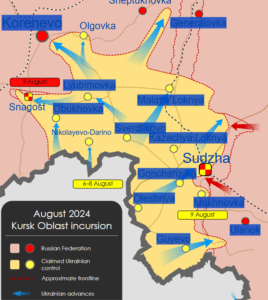
Below are (clearly quite rough) maps based on sources friendly with The Corners (and yes, they do roughly coincide).
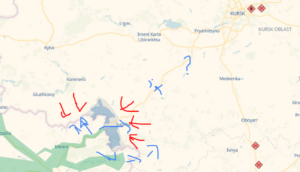
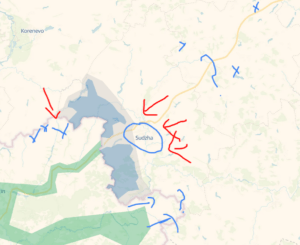
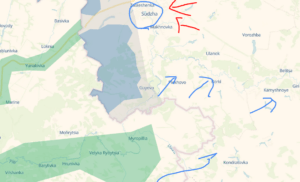
Meanwhile, green Russian forces have surrendered possibly in the hundreds. Likewise, there are reports of Chechen Kadyrov forces surrendering and Wagner reinforcements have been hard hit (and note that Wagners have faced hard times since the killing of mercurial leader Yevgeniy Prigozhin).
Moreover, there is clearly more to this than a wild jump at the behest of Budanov to conduct simply hit-and-run operations behind enemy lines. It does appear that such operations—likely conducted by highly experienced special forces—are indeed happening well behind Russian lines (one confirmed photo appeared to show Ukrainian specialists no more than 10 kilometres from Kursk), but coordinated jamming operations, mass drone attacks and the use of air cover and allied-supplied vehicles and armour are evident.

In short, this is Budanov’s move. It’s a huge gamble, but it’s very premeditated, very organized and potentially it may impact positions at anticipated negotiations in November/December.
That said… don’t count on such negotiations. Russia and Putin—in his constant, bullying desperation—is a wild card. A fire has erupted at the nuclear plant in Zaporizhzhia, and at present there have been mutual accusations as to who is at fault, as well as claims that Russia has begun burning tires there simply to sow panic. And meanwhile, the Russian drive toward Pokrovsk has not stopped.
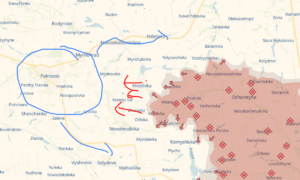
This is a worry. I have noted the logistics lines to here (and further north) in past blogs. Possibly, this drive has indeed been slowed (again, less glide bombs and troops sucked to Kursk), but if it continues at rates previously seen, this means that said logistics supply roots (highlighted in blue) will be disrupted with two to three weeks. This could cost Ukraine huge amounts of territory in Donetsk, but also all the way up through Svatove and Kupiansk (think once again: Konstiantynivka-Sloviansk-Kramatorsk-Borova-Kupiansk), but the Budanov Kursk play just may put a stop to this.
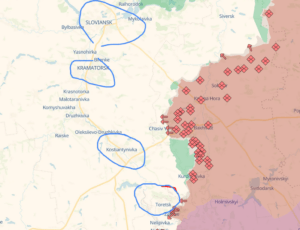
After all, there is a reason why Russia has attempted to assassinate him no less than 10 times.
Which means that (not that this is worth a great deal), from our point of view… brilliant stuff.
And…
Slava Ukrainii.
And God bless.
Preston Smith is a licensed investigator based in Gdansk, Poland. He can be reached at query@cddi.pl.
Photo of Kharkiv destruction from Aug. 6, 2024 by National Police of Ukraine, CC BY 4.0 <https://creativecommons.org/licenses/by/4.0>, via Wikimedia Commons.



